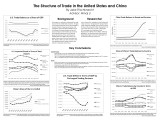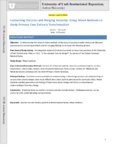|
|
Creator | Title | Description | Subject | Date |
| 1 |
 |
Maloney, Thomas N. | Higher places in the industrial machinery?: tight labor markets and occupational advancement by black males in the 1910s | The economic history of African American workers since 1940 has been marked by alternating episodes of progress and stagnation. Sharp gains in relative incomes during the 1940s were followed by little change in this measure in the 1950s. Renewed progress from the mid-1960s to the mid-1970s was follo... | Black people; Job opportunities; Labor market | 2005 |
| 2 |
 |
Maloney, Thomas N. | Living standards in black and white: evidence from the heights of Ohio prison inmates, 1829-1913 | The use of height data to measure living standards is now a well-established method in the economic history literature. Moreover, a number of core findings are widely agreed upon. There are still some populations, places, and times, however, for which anthropometric evidence remains limited. One su... | Stature, Inequality, Nineteenth century US race relations | 2008-07 |
| 3 |
 |
Maloney, Thomas N. | Ghettos and jobs in history: neighborhood effects on African American occupational status and mobility in World War I-era Cincinnati, Ohio | This article examines how residence in racially segregated neighborhoods affected the job prospects of African American men in the late 1910s. The analysis focuses on one northern city-Cincinnati, Ohio.The evidence comes from a new longitudinal dataset containing information on individuals linked... | Economic outcomes; Residential segregation; Black urban neighborhoods | 2005 |
| 4 |
 |
Maloney, Thomas N. | Degrees of inequality: the advance of black male workers in the northern meat packing and steel industries before World War II | Recent major works on long-term racial inequality in the labor market revolve around competing hypotheses concerning the importance of human capital factors (Smith and Welch 1989) and government policy (Donohue and Heckman 1991) in promoting black advance. There is however, another line or thinking ... | Labor markets; Northern employers; Racial inequality | 1995 |
| 5 |
 |
Maloney, Thomas N. | Occupation and fertility on the frontier: Evidence from the state of Utah | BACKGROUND Most of what we know about fertility decline in the United States comes from aggregate (often state or county level) data sources. It is difficult to identify variation in fertility change across socio-economic classes in such data, although understanding such variation would provide deep... | | 2014-01-01 |
| 6 |
 |
Maloney, Thomas N. | Review: Race, liberalism, and economics | Choose any two of these three topics: race, liberalism, and economics. Now trace the connections between the two that you have chosen over the course of the nineteenth and twentieth centuries, incorporating both fundamental philosophical concepts and policy implications. Doing this could easily prod... | Racism; Classical liberalism; Paternalism | 2005 |
| 7 |
 |
Jameson, Kenneth P. | Has institutionalism won the development debate? | Institutionalism has again become central to development thinking, accompanied by an appreciation of the variety and complexity of institutional evolution. The result is not the 'old institutionalism' of Thorstein Veblen and Clarence Ayres or the 'new institutionalism' of the early Douglass North. ... | Development; Institutionalism; Markets | 2006 |
| 8 |
 |
Maloney, Thomas N. | Making the effort: the racial contours of Detroit's labor markets, 1920-1940 | In 1940 the Ford Motor Company employed half of the black men in Detroit but only 14 percent of the whites. The authors postulate that black Detroiters were concentrated at Ford because they were excluded from working elsewhere. Those most affected were young married black men. A Ford job was vir... | Automotive workers - Black people; Ford Motor Company | 1995 |
| 9 |
 |
Li, Minqi | The structure of trade in the United States and China | | | 2011 |
| 10 |
 |
Li, Minqi | Rise of China and the demise of the capitalist world-economy: exploring the historical possibilities in the 21st century | China's rising importance in the capitalist world economy raises questions of world-historic significance. How is China's internal social structure likely to evolve as China assumes different positions in the existing world system? Will China's current regime of accumulation survive the potential pr... | World economy; China; Economic development | 2005 |
| 11 |
 |
Maloney, Thomas N. | Personnel policy, costs of experimentation, and racial inequality in the Pre-World War II North | Between 1910 and 1940, the black population of the northern United States nearly tripled, rising from just over I million to more than 2.7 million, signaling the start of the "Great Migration" of African-Americans out of the South. As black workers entered the North, they sought positions in new sec... | Race bias; Personnel policies; African Americans; Employment opportunities | 1999 |
| 12 |
 |
Maloney, Thomas N. | Wage compression and wage inequality between black and white males in the United States, 1940-1960 | The gap between the mean wages of black men and white men in the United States narrowed substantially between 1940 and 1950. There was, however, almost no change in this wage gap between 1950 and 1960. Some of this discontinuity in the path of black progress can be explained by general changes in th... | Salaries; Race; Compensation | 1994-06 |
| 13 |
 |
Jameson, Kenneth P. | Institutions and development: what a difference geography and time make | Ha-Joon Chang, in his article ?Institutions and Economic Development: Theory, Policy, and History?, provides a description and critique of the mainstream view of institutions and development. It applies well to Latin America in the 1980s and 1990s. However, the effort to introduce these Anglo-Americ... | | 2011 |
| 14 |
 |
Jameson, Kenneth P. | Determinants of Latin American exchange rate regimes | The experience of the last thirty years suggests that a wide range of factors affects policymakers' choice of exchange rate regime. The initial explanation was that changes in the international sphere dominated domestic policies and strongly influenced how governments decided among the trade-offs. M... | Monetary policy; Exchange rate regimes | 2005 |
| 15 |
 |
Li, Minqi | Dialogue on the future of China | Three Chinese scholars speak to the question: How do you think the June 4th movement of 1989 will be remembered-----as another May 4th 1919, the threshold of a period of general political awakening and turbulence, or instead as a Chinese version of 1848 or 1968 in Europe: a last spontaneous explosio... | China; Politics; Social conditions | 1999 |
| 16 |
 |
Waitzman, Norman J. | Connecting the dots and merging meaning: using mixed methods to study primary care delivery transformation | Objective: To demonstrate the value of mixed methods in the study of practice transformation and illustrate procedures for connecting methods and for merging findings to enhance the meaning derived.. Data Source/Study Setting: An integrated network of university-owned, primary care practices at the ... | | 2013-01-01 |
| 17 |
 |
Li, Minqi | China: hyper-development and environmental crisis | China's spectacular economic growth has been one of the most dramatic developments in the global economy over the past quarter century. Between 1978 and 2004 the Chinese economy expanded at an annual rate of 9.4 per cent. No other large economy has ever grown so rapidly for so long in the economic h... | China; Economic growth; Environmental impacts | 2007 |
| 18 |
 |
Jameson, Kenneth P. | Data and social science rhetoric: policy and instruction | I believe that social science and empirical investigation can make important contributions to our understanding and to resolution of policy issues, but only if we are clear on the nature of social science and the role of quantification. In particular we must admit the limits of our truth claims, th... | Social sciences; Quantification; Empirical investigation | 1996 |
| 19 |
 |
Li, Minqi | After neoliberalism: empire, social democracy, or socialism? | Analyzes political doctrines such as imperialism, social democracy and socialism as a possible economic trend after the neoliberalism era. Characteristics of neoliberal regime; Alternative scenarios of global economic crisis; Problems that a revived social democratic capitalism would not address; Ac... | Political doctrines; Liberalism; Imperialism | 2004 |
| 20 |
 |
Bilginsoy, Cihan | The hazards of training: attrition and retention in construction industry apprenticeship programs | Apprenticeship programs in the United States, which provide workers with the broad-based skills required for practicing a trade via on-the-job training, are sponsored either unilaterally by employers or jointly by employers and trade unions. A comparison of the attrition and retention rates in these... | | 2003 |
| 21 |
 |
Von Arnim, Rudiger Lennart | Structural transformation in China and India: the role of macroeconomic policies | This paper explores macroeconomic policies that can sustain structural change in China and India. A two-sector open-economy model with endogenous productivity growth, demand driven output and income distribution as an important determinant of economic activity is calibrated to a 2000 SAM for China a... | | 2012-01-01 |
| 22 |
 |
Jameson, Kenneth P. | Castle or the tipi: rationalization or irrationality in the American economy | During a 1957 Notre Dame conference entitled "What America stands for", Karl De Schweinitz, Jr. examined the "contemporary problems of the American economy'. | American economy; Power; Economic imperatives | 1972-10 |
| 23 |
 |
Holzner, Claudio A.; Jameson, Kenneth P.; Maloney, Thomas N.; Abebe, Berhanie; Lund, Matthew; Schaub, Kristen | Economic impact of the Mexico-Utah relationship | This study began during the Summer of 2005 and set out to examine the complexity of the globalized relation between Utah and Mexico, concentrating on broadly defined "economic linkages." It was designed to build upon earlier similar studies done in Arizona and in Texas on those states' relations wit... | Economics, Utah; Migration; Immigration; Mexico; Undocumented immigrants | 2006-03-10 |
| 24 |
 |
Li, Minqi | Secular trends, long waves, and the cost of the state: evidence from the long-term movement of the profit rate in the U.S. economy | Theorists in the tradition of either Classical Marxism or Keynesianism understand that as capitalism provides an historical space for the development of material forces of production, its economic and social contradictions tend to develop, requiring progressively more complex institutional structure... | Marxism; Social structures of accumulation; Neoliberalism | 2006 |
| 25 |
 |
Jameson, Kenneth P. | Dollarization in Latin America: wave of the future or flight to the past? | Ecuador undertook official dollarization in 2000 when it destroyed its own currency, the sucre, and adopted the dollar. El Salvador converted all financial instruments to dollars, and Guatemala now allows transactions to be carried out in any currency. Both assumed that the dollar would soon displac... | Domestic currencies; Latin America; Dollarization | 2003 |

























